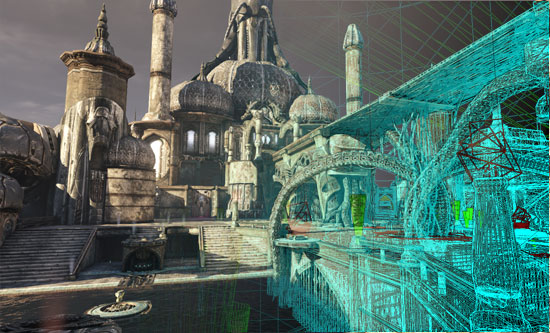Modular Level Design
for Skyrim
by Joel Burgess and Nathan Purkeypile (Bethesda Game Studio)
Bethesda games are BIG.
Scope is an integral part of the experience (delays don’t
lose weeks, but months).
“…always move forward to explore our new ideas.”
Bethesda has efficiency focused studio culture.
KITS – A contextual system snapped to grids that is more than a sum of its
parts.

Pros (+) and Cons (-) of Modular Level Design
+
Reusable art mitigates scope.
Beliefs
+ Circumstances + Experience = Culture
- Art fatigue happens (breaking immersion
from recognizing assets in-game).
Abolish copy-paste design!
Disassociate enemy types and
gameplay with setting.
Encourage asset mix-n-match when
laying-out a level.
Artists need to ‘let go’ of
protecting assets from being warped and edited.
+ Low artist / designer ratio.
- High complexity exists (artists
need to know a lot of left- and right-brain techniques to be useful).
Modular
design requires an art and technology understanding.
Bug
fixing can be delicate.
+ Instant, game-wide art
deployment.
Zero
impact on the design workflow.
Artwork
is viewable in a ‘real’ context.
There’s
cosmetic control with art (the aesthetic process is not rushed).
+ Iteration speed is quick.
High
flexibility and agility when making levels.
1:1
correlation with final layout (fastest workflow ever?).
- The process has a dependence on
art.
An
art and design relationship is imperative.
The
process must use abstract units for scale.
Set
standards for doorframe sizes.
Set
a minimum standard for width of a space.
Figure
out inclined angles that are traversable and what is too steep.
KIT Building
Concept Phase (a week or so timeline)
Art:
What is the visual theme? What is the
visual goal?
How
widely is this KIT used?
What
sub-KITs are needed? (The Cave KIT has large hall, round hall, etc.)
Proof Phase (2-3 weeks)
512x512x512
dimension sizes were used (these can change per project, however).
All
sub-KITs are multiples of the standard sizes.
Keep
grid snaps large!
Don’t
tile on all 6 axis.
Don’t
build outside of a ‘footprint’ space when designing.
Greybox Core Phase (1-4 weeks)
Greybox
the most used sub-KIT as a priority.
Focus
on function, not aesthetics.
Naming
conventions should be used and must be consistent (while avoiding
abbreviation); decide on conventions early because they are difficult to change
later.
Use
‘01’ as a suffix for all assets.
[KIT
name]-[sub-KIT]-[object name]-[suffix] // An example of naming an asset.
Pivot
placement is decided on usage and design (there are exceptions).
Test
all greyboxing.*
Build-Out Phase (4-8 weeks)
Create
one ‘visually final’ piece before building the whole KIT.
Avoid
Hero pieces (a single-use statue worked-on for 2 months).
Helper
markers (placed on the roof of a piece) give a run-down of the info of a piece.
Polish Phase!
Avoid
the temptation to add every suggested piece.

Art / Design Compromises
Art: It looks better, but takes longer.
Design: It helps in gameplay and world-building, but it’s
harder to work with.
Read: Modular Level
and Component Design by Lee Perry.
* Don’t test in comfortable settings / ideal conditions.
Common
problem: Loopback issues.
Avoid
‘Patch’ pieces (no band aids!).
Find
footprint issues.
Common
problem: Unable to stack (co-planar issues).
Define
common ‘gaps’.
Common
problem : The ‘Hall Room’.
Somebody
will try unsupported issues (does the system support it or no?).// NEXT - The Future of Storytelling: How Medium Shapes Story by Jesse Schell
No comments:
Post a Comment